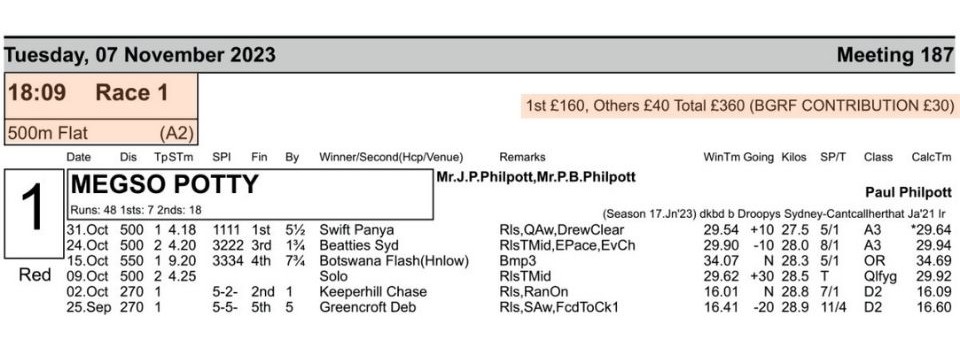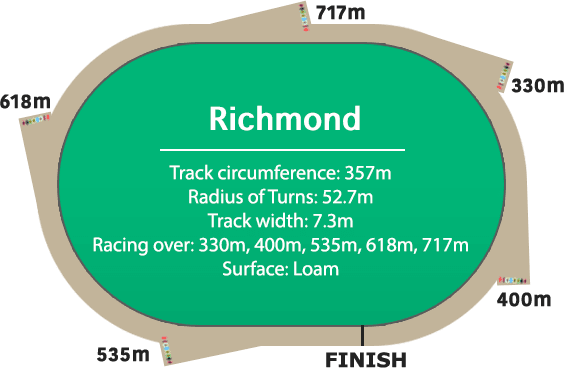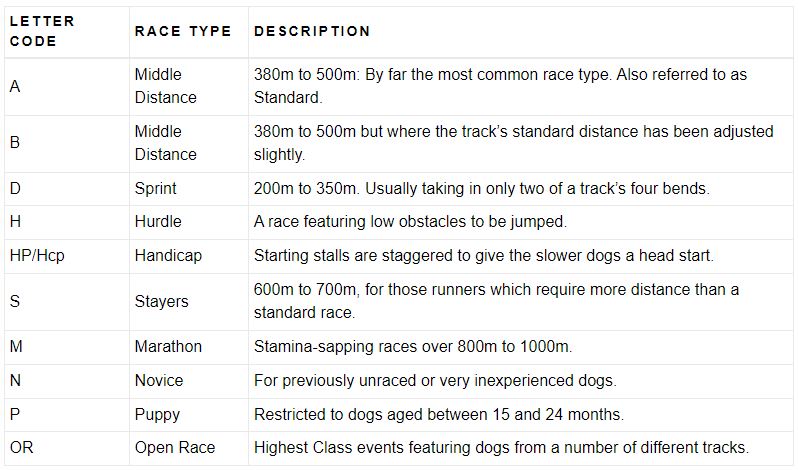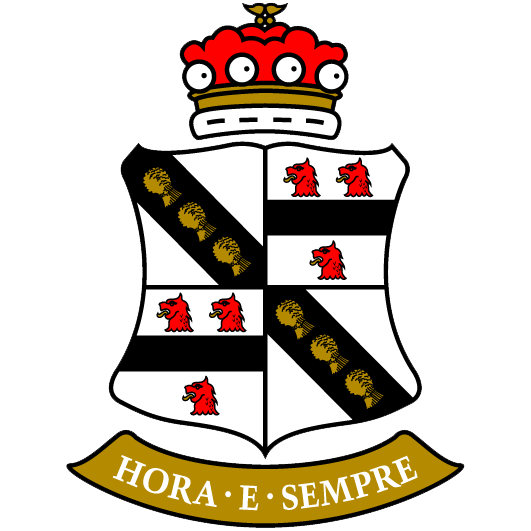Newcomers to greyhound racing can often be completely baffled when they first look at a racecard. But I’m here to assure you that after reading this article, you’ll no longer be confused, and you will have the ability to assess greyhound form and get the bookies worried!
So let’s take a deep dive and unlock the meaning of a greyhound racecard by looking at the first race of the evening that took place at Towcester Racecourse on Tuesday 7th November 2023:

6 dogs are going to compete in this race. This is what you can read BEFORE the race starts. It’s NOT the 7 November race results.
We will now break down each section and explain exactly what each part means.
Top Section

This is mostly self explanatory:
The grey top section is the day and date the race is taking place. It’s the 187th race meeting to take place at Towcester Racecourse.
The highlighted part on the left
- The time the race is due to start (18:09)
- It’s the first race of the meeting (Race 1)
- The race distance (500 meters) and that it is a Flat race like nearly all Greyhound races and not a hurdles race (very rare nowadays).
- A2 is the Grade of the race. As you can see it’s in 2 parts: a letter (A in this case), and a number (2 for this race). The letter is what type of race it is. “A” is a Middle Distance race between 380m to 500m, which is the most common type of race in Greyhounds. It’s also known as a Standard race. The number 2 refers to the talent level of the dogs in the race. For middle distance A races it goes from A1 for the most talented dogs and runs all the way down to A11 for the slowest dogs. This race (A2) therefore features the second fastest of the dogs that run at Towcester.
The highlighted part on the right details:
- The payment for finishing in first place (£160)
- The payment for all the other dogs (£40)
- The total prize money for the race. – £160 for the winner plus (£40 x 5 other dogs = £200) = £360 in total.
- BGRF stands for the British Greyhound Racing Fund which receives voluntary contributions from bookmakers. It contributed £30 to the prize money for this race.
So that’s the top section covered, which deals with the overall race information.
Individual Greyhound Form
Now we come to the part that has most people baffled at first, which deals with each of the 6 dogs in the race. To make it easier to understand, let’s just separate it out into the section for the dog called MEGSO POTTY starting in trap 1.

Essentially, it’s just a spreadsheet with information about the Greyhound. Notice that the top part is like the top header row of a spreadsheet or table, and there are 15 columns of data as you can see below:

Now we will look at each part of the section.
Name, Runs, 1sts and 2nds

Megso Potty is the name of the Greyhound. Runs 48 means she has had 48 runs which includes races and trials. She’s finished 1st 7 times and 2nd 18 times.
Trap and Color

This greyhound is starting in trap (or box) 1 and wearing a red racing jacket.
Previous Six Runs

The area here gives details of the Greyhound’s previous 6 runs. There is a lot of information to digest here, so we will break it down column by column.
Date of Race or Trial

These are the dates on which Megso Potty ran in her previous 6 runs.
Race Distance

This column shows the length of her last 6 runs on each date. Dis = distance. The distances are in meters.
Trap Number

Tp stands for Trap. This Greyhound has been starting from traps 1 and 2 for the last 6 runs.
Split Time

STm stands for Split Time. The split time is how long it took the dog to cross the finishing line the first time after the race starts. The numbers are the time in seconds and just like Olympic Sprinters they are measured to a hundredth of a second. The traps in standard and longer races are positioned at different places several meters before the finishing line. Take a look at the image below which is of a greyhound track in Australia:

If we take the 535m race as an example, the dogs will leave the traps and cross the finish line for a first time, then carry on running all the way around the track and cross it again after 535m – the actual end of the race. The longer the race, the further before the finish line the traps are positioned. So in the column of the racecard highlighted above, MEGSO POTTY in her last 4 runs, crossed the finish line the first time (the Split Time) in just over 4 seconds, except on the 15 October. That race was different though. It took her over 9 seconds. The reason being was she was bumped into by another dog (we’ll look at that later under the column “Remarks”.)
Now look at the runs she had on 25. Sep. and 02. Oct. No split time. Why? Well, the races were only 270m. If you look at the diagram of the track above, the shorter races (400m and 330m) start after the finish line. So the dogs only cross the finish line once, at the end of the race, not twice, and hence there is no Split time to be recorded.
Punters use the split time to assess a dog’s speed out of the traps. They can then compare these times to the times of other dogs in the race and make a judgement on how to bet.
Sectional Placing

SPl refers to Sectional Placings. The Sectional Placings are the dog’s position at 4 or 2 different places around the track (the start of the turns) during a race. If you look at Megso Potty’s Sectional Placings for 31 October, she was in first position at all points. The week before on 24 October, she was in 3rd place out of the traps, went ahead to 2nd position for the next 3 sections, but was beaten back to 3rd place at the finish. The two 270m races show only 2 Sectional Placings as they only go partially around the track (2 bends only). Modern technology enables sensors to be put into Greyhound race jackets to monitor their positions at different stages of a race.
Finish Position

Fin shows what place the dog finished. Notice it is blank for 9 October. This was a solo trial run, not a race.
Won or Lost By (Lengths)

By stands for won or lost by, stated in lengths (length of an average greyhound). In the past, before sophisticated photography and speed measuring equipment, greyhounds were recorded as winning or losing by body-lengths. Nowadays we still use this terminology but it’s actually measured in increments of time, each “length” being 0.8 seconds on most tracks. In her winning race on 31 October, Megso Potty was 5 1/2 lengths in front of the second place dog. The week before on 4 October, she came in 3rd, 1 3/4 lengths behind the winner.
Winner / Second / Handicap / Venue

In this column we have the names of the winning or second place dogs in the races. So on 31 October, when Megso Potty finished 1st, the 2nd place dog was Swift Panya. On 24 October, when Megso Potty finished 3rd, the column records the name on the winning dog, Beatties Syd. Hcp stands for handicap race (none in the 6 races in this case). Venue is just that a venue, but different to the venue the dog normally runs at. So on 15 October, Megso Potty ran at Hnlow – Hounslow race track, not her usual Towcester.
Remarks

Remarks are the comments attached to a greyhound’s performance during a race. It’s in abbreviated form so that it fits as much information as possible about the dog’s performance in the least amount of space as possible. There are dozens of abbreviations used on greyhound race cards, so I will leave a list of them at the end. But we can look at a few that have been used here to comment on Megso Potty’s performances:
- 31 October: Rls (rails, meaning she ran on the inside next to the rails). QAw (Q – quick, Aw – away. So a fast start). DrewClear (simply drew clear of the other dogs).
- 24 October: RlsTMid (ran from the rails to the middle of the track). EPace (showed early pace on the run up). EvCh (had every chance – wasn’t bumped or crowded – but still didn’t win.
- 15 October: Bmp3 (bumped into by another dog at Sectional Place 3).
- 9 October: RlsTMid (ran from the rails into the middle). She ran Solo and it was a Trial run.
- 2 October: Rls (as above). RanOn (sometimes spelt RnOn. Means ran on, i.e. kept going strongly).
- 25 September: Rls. SAw (slowly away – started slowly). FcdToCk1 (Forced to check to avoid running into another dog at split 1. In other words forced to slow down or change direction).
Check the list below for all the other common abbreviations used in racecards. Bear in mind that there are small differences from track to track.
Winning Time

WinTm: This is the time of the winning dog, or the time a dog ran a trial.
Going and Calculated Time

Going and Calculated Time. Going, just as in horse racing, refers to the condition of the running surface. Nearly all greyhound races are run on sand. Positive or negative numbers represent quick or sluggish conditions, expressed in hundredths of a second — N symbolizes the Normal going condition. Notice that the value for the race on 31 October is +10. This is added to the winning time (29.54) to give us the Calculated Time (CalcTm) in the final column. (The race the previous week had 10 hundredths of a second subtracted.) All of this is to give punters a better and fairer assessment of the dog’s form, taking into account different track conditions.
Greyhound Weight

This column is the weight of the dog in Kilos. Greyhounds are weighed before every race. The weighing unit used for greyhounds varies according to regional norms. Here’s the breakdown:
United Kingdom, Europe, Australia, and New Zealand: Greyhounds in these regions are weighed using the metric system (kilograms).
United States and Ireland: Greyhounds here are typically weighed using the imperial system (pounds).
Dogs and bitches vary in weight and height:
| Category | Average Weight (kgs) | Average Height (cms) |
|---|---|---|
| Dogs | 28 – 36 | 71 – 76 |
| Bitches | 22 – 31 | 68 – 71 |
These differences in body measurements between dogs and bitches play a significant role in greyhound sporting and racing, directly influencing their performance, speed, and endurance.
Rule 52 of UK Greyhound Racing as laid down by the GBGB sates: A Greyhound whose weight at the time of Kennelling prior to a Race varies by more than 1 kilogram from its weight as shown in the form line for its previous Trial or Race, shall be withdrawn and shall run at least one Trial before it races subsequently.
Starting Price / Trial

In greyhound racing, the Starting Price (SP) refers to the odds given to a greyhound at the start of a race, just before it begins, based on the bets placed and the perceived chances of the greyhound winning the race. T signifies that the run was a Trial. There is no betting on Trials.
Class

Class consists of two elements:
- The type of race (there are 10 in total A, B, D, H, HP/Hcp, S, M, N, P, OR) See table below.
- The ability / speed of the dog (1-11), the lower the number, the faster the dog.

Note: On 9 October Megso Potty had a Qlfyg run which is a Qualifying Trial run.
Owner and Trainer

The names on the left are the owners, and on the right is the name of the trainer. In this case it looks like the trainer is also one of the owners.
In Season

This date is when the greyhound was last in season. A heat, or season, is a female dog’s fertile phase, often starting at about 6 months of age and recurring every 6-7 months for roughly 16-18 days each cycle. Obviously, this information only applies to bitches!
Rule 56 states: A bitch may not run in any Trial or Race after coming in season, for a minimum period of 21 Days nor until, in the opinion of the Racecourse Veterinary Surgeon, it is fit to do so subsequently.
Colour and Gender

dkbd: This is the colour of the dog. dk = dark, bd = brindle. b = bitch
Dam / Sire / Whelped

This section details the dog’s parent and when and where it was born. In greyhound terminology the father is know as the Sire, and the mother the Dam. Droopys Sydney is the Sire and Cantcallherthat is the Dam. Ja’21 Ir means the dog was whelped (born) in January 2021 in Ireland.
Abbreviations
| Abbreviation | Meaning |
|---|---|
| 1 | 1st bend (2 = 2nd bend etc) |
| 1/2 | Between the 1st and 2nd bends |
| 1-2 | From the 1st bend all the way to the 2nd bend |
| ALd | Always led (led from start to finish) |
| Awk | Awkward (turned its head towards another dog rather than concentrating on the race) |
| Bd | Badly (BdBmp = badly bumped) |
| Blk | Baulked (ran into another dog) |
| Bmp | Bumped by another dog |
| Chll | Challenged for the lead |
| ClrRn | Clear run (wasn’t bumped or crowded) but still didn’t win |
| Ck | Checked (hesitated) |
| Ckd Sough | Hesitated halfway down the back straight |
| CmAgn | Came again (put in another big effort) |
| CmOffLm | Came off lame (was found to be injured after the race) |
| Crd | Crowded by other dogs |
| Crmp | Had an attack of cramp |
| dht | Dead heat |
| DInt | Deliberately interfered with another dog during the race |
| Disq | Disqualified (usually after acting aggressively towards another dog) |
| Dist | Finished a long distance behind the rest of the dogs |
| dnf | Did not finish |
| DrwClr | Drew clear of the rest of the field |
| Eased | Slowed down (usually approaching a bend) |
| EP | Showed early pace on the run up |
| EvAw | Evenly away (came out of the traps level with the other dogs) |
| EvCh | Had every chance (wasn’t bumped or crowded) but still didn’t win |
| Fcd-Ck | Forced to check to avoid running into another dog |
| FcdWd | Forced to run wide around the bend |
| Fdd | Faded (ran out of puff) |
| FnWll | Finished well (ran strongly up the home straight) |
| GdMiddle | Ran well up the back straight (the middle section of the race) |
| HldOn | Held on (kept the lead despite coming under pressure from another dog) |
| Imp | Impeded by another dog |
| KO | Knocked over |
| Lckd | Lacked (LckdEP Lacked early pace) |
| Ld | Led |
| LftClr | Left clear (after other dogs collided) |
| Lm | Lame (i.e. was injured during the race) |
| Mid | Ran in the middle of the track |
| MsdBk | Missed break (came out of the traps late) |
| MsdTrbl | Missed trouble (avoided a collision affecting other dogs) |
| MvdOff | Moved off (left a gap for other dogs to pass on the inside) |
| NrLn | Near the finishing line |
| NvrShwd | Never showed (did not look competitive at any stage) |
| OutP | Outpaced (simply not quick enough to be competitive) |
| QAw | Quickly away (a fast start) |
| Rls | Ran close to the inside rail |
| RnIn | Run-in (the closing stages of the race) |
| RnOff | Ran off the track at the bend |
| RnOn | Ran on (kept going strongly) |
| RnUp | Run-up (the run from the traps to the first bend) |
| SlAw | Slowly away (started slowly) |
| SnLd | Soon led (took the lead early in the race) |
| StkRl | Struck the inside rail when going round the bend |
| Stmb | Stumbled |
| Stppd | Stopped |
| StrFn | Strong finish (came with a late run) |
| Stt | Start (StmbStt = Stumbled start – almost fell over coming out of the traps) |
| Styd | Stayed (kept running strongly all the way to the line) |
| ThrOut | Throughout the race (ChllThrOut = Challenged for the lead all the way round) |
| TndInTrps | Turned in the traps (so was facing the wrong way when the race started) |
| UpWthTrps | Rose up on hind legs as the traps opened |
| V | Very (VQAw = Very quickly away) |
| W | Ran wide on the right-hand side of the track |
| Wtd | Slowed down when leading and waited for other dogs to catch-up |




